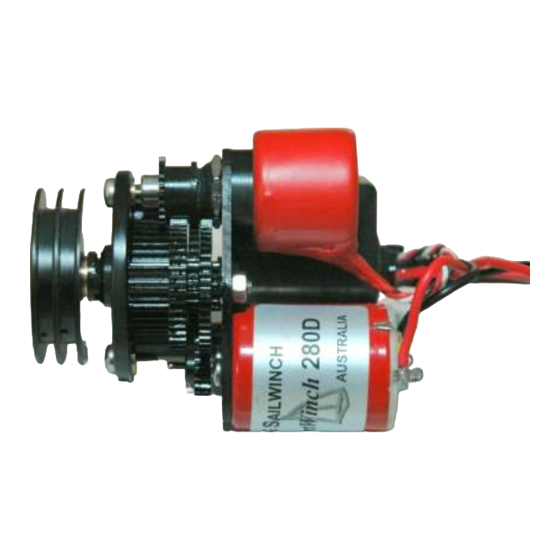
Table of Contents
Advertisement
Advertisement
Table of Contents

Summary of Contents for RMG SailWinch SmartWinch 280D
- Page 1 RMG S AILWINCH SmartWinch U S E R G U I D E...
-
Page 2: Table Of Contents
16. Electrical Specifications ........13 The SmartWinch is manufactured by RMG SAILWINCH 66 Radford Rd... -
Page 3: Introduction
1. Introduction Thank-you for purchasing a SmartWinch. We hope you have many years of trouble free and successful sailing using our product. If there are any problems to be solved or queries to be answered please do not hesitate to call. Please take the time to read this booklet through. - Page 4 Stall Protection When a conventional winch becomes stalled, it will stay stalled until the problem is solved or the battery is flattened or the electronics damaged etc. But the SmartWinch knows when it is stalled and can protect itself by shutting down. The winch then signals that it is stalled by sounding a two-tone beep at 2 second intervals until reset.
-
Page 5: Batteries
Table 1 Level Detect Warn Shutdown 6V gel cell < 6.5 < 5.1 < 5.0 5 cells > 6.5 < 5.5 < 5.0 6 cells > 7.5 < 6.6 < 6.0 Battery Monitoring Voltages 4. Batteries Voltage Range Supply voltage range is from 3.8V to 9V. Should a voltage outside that range be applied the winch will not operate. -
Page 6: Wiring
5. Wiring Regulator The SmartWinch contains a 5 volt regulator which can supply up to 1 amp of current to the controller circuit, radio receiver (rx) and rudder servo. This allows for the use of only one battery pack inside the yacht. The motor runs on the full battery voltage via the MOSFET output circuit. -
Page 7: Standard Connections
6. Standard Connections In most cases the best circuit for winch, radio and battery is also the simplest as shown in figure 3. In this system there must be no receiver battery connection. Power for receiver is supplied by internal 5 volt regulator. Fig. -
Page 8: Mounting
8. Mounting Deck Mounting The recommended method of mounting the winch is to fix it to the underside of the deck with output shaft passing through the deck. Maximum deck thickness 3mm. Sealing Prior to fixing the winch to the underside of the deck, the mounting face, spigot and "V"... -
Page 9: Sheeting
9. Sheeting Drum Size vs Performance Unless specified otherwise when ordering, the 280D and 280DL are supplied with a 26mm drum. The 380D and 380HD are supplied with a 32mm drum. If faster or slower performance is desired an extra drum may be purchased. Write or phone for pricing. -
Page 10: Setting Up
Fig. 7 Sheeting 10. Setting Up It is not essential to perform the setup procedure to use the winch. Each winch has “factory default” settings. However, setting TX end points and Travel is recommended to give the overrun protection. Setup can be performed as many times as desired. Each time setup is performed, the previous settings are overwritten. -
Page 11: Setting Tx End Points, Travel And Battery Monitoring
11. Setting TX End Points, Travel and Battery Monitoring These settings must be done in sequence. For example, to make an adjustment to travel, the TX end points must be set at the same time. Start with; Winch off, TX on, RX lead plug out of RX, TX stick at close hauled and trim set to minimum. -
Page 12: Adjusting Deceleration, Scaled Linear Travel, Speed & Dead Band
Drive winch out (using TX stick) till the main boom is at the desired fully sheeted out position. With the winch in this position, pause for at least one second without moving the winch, then remove RX plug. Three beeps indicates that the new travel setting is stored. If you do not wish to make any changes to your battery monitoring settings, switch winch off now and setup is complete. - Page 13 Deceleration Rate Adjustment Turn Winch on and wait 14 seconds till the 3 rising tones signal then push plug into RX within 2 seconds. If a single long beep is heard, the adjustment has been noted. If not then the plug was not inserted in time so turn winch off and start again.
-
Page 14: Maintenance
14. Warranty Your new SmartWinch is covered by a 12 month warranty. Should any faults be found and are considered by RMG SailWinch to be our fault, we will repair and return the winch to you free of charge. Sm artW inch U ser G uide page 12... -
Page 15: Mechanical Specifications
15. Mechanical Specifications Table 2 Specification 280D (DL) 380D (HD) Unit M ax P ower 10.7 14.3 W atts N o Load Speed 4.4(3.1) revs/sec N o Load Speed 359 (286) m m /sec S tall Torque 15.9 (19.9) 29.9 k g.cm S tandard D rum M axim um T urns...
Need help?
Do you have a question about the SmartWinch 280D and is the answer not in the manual?
Questions and answers
Why winch jerky motion when bringing main in under load?
The RMG SailWinch SmartWinch 280D may have jerky motion when bringing in the main under load due to the input dead band setting. If the dead band is too small, the servo may constantly jitter in response to small variations in the RX signal. Adjusting the input dead band between 2 to 15 microseconds can help smooth out the motion. Additionally, overshooting and hunting caused by supply voltage variations may also contribute to the issue, so experimenting with the default setting (70% of maximum) may help.
This answer is automatically generated